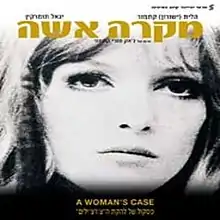A Woman's Case
A Woman's Case (Hebrew: מקרה אישה, tr. Mikreh Isha) is a 1969 black and white Israeli independent underground experimental dramatic art film, the first Israeli film to be screened at the Venice Film Festival, directed by Jacques Katmor, and, usually, categorized as belonging to the bohemian/counterculture and anarchistic New Sensitivity movement.[1][2] The film was released on DVD by NMC Music.[3] Cinematographer and coscreenwriter Amnon Salomon stated, during an interview, held late in life, that the film's origin is in Katmor's early exhibition, dealing with the female body, and, that no commercial motivations were held by the filmmakers.[4]
| A Woman's Case | |
|---|---|
 DVD cover | |
| מקרה אישה | |
| Directed by | Jacques Katmor |
| Produced by |
|
| Written by | |
| Starring |
|
| Music by |
|
| Cinematography | Amnon Salomon |
| Edited by | Nellie Gilad |
Production company | Lamut Le'at Ltd. |
Release date |
|
Running time | 82 Minutes |
| Country | Israel |
| Language | Hebrew |
Synopsis
This modernist and non-linear film, influenced by the French New Wave, and, especially, by films such as Jules and Jim and Breathless, tells the story of an advertiser (Yossi Spector), in his forties, who, meets Helit (Helit Yeshurun), a model, in her twenties, and, together, the two spend a day in Tel Aviv and Jerusalem, The model leads the advertiser into cafés and drug-fueled orgies, while, he leads her into the workshops of sculptors, so, that they could create sculptures, modeled on her body, out of gypsum. While she tries to liberate his mind, he attempts to stay where he is. The film ends with the advertiser strangling Helit to death, during a sadomasochistic session.[5]
Reception
Maariv compared the film to the works of James Joyce, Jean-Luc Godard, and, Michelangelo Antonioni, with the acting of Helit Yeshurun being compared to that of Monica Vitti,[6] writer Yoram Kaniuk wrote that the film is a critique of the horrors of the modern world,[7][8] and, Davar compared the film to painting.[9] The film, however, was a commercial failure, with only 38,000 tickets sold, due to its highly avant-garde nature.[10] University of Haifa sociologist, Prof. Dr. Oz Almog, wrote that film's main theme is the independent woman's, unsuccessful, attempt to free the man, from the shackles of his masculinity, and, noted that it was one of the first Israeli films to express their director's personal view.[11]
References
- Shem-Or, Mirit (2 December 1969). „מקרה אישה” בפסטיבל ונציה [A Woman's Case at the Venice Film Festival]. Davar (in Hebrew). Tel Aviv. Retrieved 3 April 2017.
- Krishek, Tzvi (1 January 1970). מקרה סרט [A Film's Case]. Maariv (in Hebrew). Tel Aviv. Retrieved 3 April 2017.
- Katmor, Jacques (11 January 2009). מקרה אישה [A Woman's Case] (in Hebrew). Ramat HaSharon: NMC Music. OCLC 436441730. 6214315. Archived from the original (DVD) on 4 April 2017. Retrieved 4 April 2017.
- Parkhomovsky, Marat (7 December 2010). אמנון סלומון [Amnon Salomon]. Israeli Cinema Testimonial Database (in Hebrew). Retrieved 12 May 2017.
- Levy Ben-Zakai, Talila (9 October 1969). הלית [Helit]. Maariv (in Hebrew). Tel Aviv. Retrieved 3 April 2017.
- Porath, Yoram (3 July 1969). כתבה על עשיית הסרט [A Report on the Film's Making]. Maariv (in Hebrew). Tel Aviv. Retrieved 3 April 2017.
- Kaniuk, Yoram (5 December 1969). על הסרט „מקרה אישה” [On the Film A Woman's Case (Part I)]. Davar (in Hebrew). Tel Aviv. Retrieved 3 April 2017.
- Kaniuk, Yoram (5 December 1969). על הסרט „מקרה אישה” [On the Film A Woman's Case (Part II)]. Davar (in Hebrew). Tel Aviv. Retrieved 3 April 2017.
- מראשו של צייר אל הבד [From a Painter's Mind to the Cloth] (PDF). Davar (in Hebrew). Tel Aviv. 28 November 1969. Retrieved 3 April 2017.
- Rappaport, Azaria (26 October 1969). אמנות – ליחידה־סגולה בלבד? [Art – Only for the Privileged?]. Maariv (in Hebrew). Tel Aviv. Retrieved 3 April 2017.
- Almog, Prof. Dr. Oz (2004). פרידה משרוליק: שינוי ערכים באליטה הישראלית [Farewell to “Srulik:” Changing Values Among the Israeli Elite] (in Hebrew). II. Haifa and Or Yehuda: Haifa University Press and Kinneret Zmora-Bitan Dvir. pp. 659, 886, 915, and, 1278. ISBN 9789653110519. OCLC 56795640.